The Development of Fiber–Cement Flat Sheets by Young and Mature Coconut Fibers to Replace Asbestos for Eco-Friendly Products
Abstract
1. Introduction
2. Materials and Methods
2.1. Materials
2.1.1. Binders
2.1.2. Fine Aggregate
2.1.3. Coconut Fibers
2.2. Sample Preparation
2.3. Testing Procedure
2.3.1. Bulk Density
2.3.2. Modulus of Rupture
2.3.3. Elastic Modulus
2.3.4. Thermal Conductivity
2.3.5. Microstructure
3. Results and Discussion
3.1. Bulk Density
3.2. Modulus of Rupture
3.3. Elastic Modulus
3.4. Thermal Conductivity
3.5. Microstructure Results
4. Conclusions
- (1)
- Asbestos in flat sheets was replaced by young coconut and mature coconut, which represents innovative research on the application of natural fibers in construction.
- (2)
- Fiber–cement boards with YCF had densities of 1399–1882 kg/m3, while those with MCF ranged from 1498 to 1993 kg/m3. Adding coconut fiber (5–9.5%) reduced density and increased porosity. In terms of mechanical properties, the modulus of rupture peaked at 12–13 MPa for both fiber types with an optimum content of 6.5–7% by weight of binder.
- (3)
- A good relationship between the modulus of elasticity and modulus of rupture was found. The modulus of elasticity (E) and modulus of rupture (Rf) showed a strong correlation (R2 = 0.71), with E ranging from 4.789 GPa to 11.801 GPa. A higher Rf led to a higher E, improving deformation capacity and load redistribution. Coconut fiber type had minimal impact on this relationship.
- (4)
- The thermal conductivity of fiber–cement sheets decreased with higher YCF (0.334 to 0.224 W/mK) and MCF (0.354 to 0.245 W/mK) content. Strong correlations between bulk density and thermal conductivity were observed.
- (5)
- The flat sheets made with mature coconut fiber had denser microstructure than the flat sheets made with young coconut fiber based on SEM results.
Author Contributions
Funding
Institutional Review Board Statement
Informed Consent Statement
Data Availability Statement
Acknowledgments
Conflicts of Interest
References
- Hosseinpourpia, R.; Varshoee, A.; Soltani, M.; Hosseini, P.; Tabari, H.Z. Production of waste bio-fiber cement-based composites reinforced with nano-SiO2 particles as a substitute for asbestos cement composites. Constr. Build. Mater. 2012, 31, 105–111. [Google Scholar] [CrossRef]
- Peña-Castro, M.; Montero-Acosta, M.; Saba, M. A critical review of asbestos concentrations in water and air, according to exposure sources. Heliyon 2023, 9, e15730. [Google Scholar] [CrossRef] [PubMed]
- Lertwattanaruk, P.; Suntijitto, A. Properties of natural fiber cement materials containing coconut coir and oil palm fibers for residential building applications. Constr. Build. Mater. 2015, 94, 664–669. [Google Scholar] [CrossRef]
- Elfaleh, I.; Abbassi, F.; Habibi, M.; Ahmad, F.; Guedri, M.; Nasri, M.; Garnier, C. A comprehensive review of natural fibers and their composites: An eco-friendly alternative to conventional materials. Results Eng. 2023, 19, 101271. [Google Scholar] [CrossRef]
- Lertwattanaruk, P.; Makul, N.; Masuwan, K. Experimental study of acoustical insulation of cement-based board prepared with wasre coconut coir and ould palm fibers. J. Green Build. 2021, 16, 63–80. [Google Scholar] [CrossRef]
- Ramli, M.S.; Abas, N.F.; Mydin, M.O. Investigation of mechanical properties of coconut fiber as a concrete admixture. In MATEC Web of Conferences; EDP Sciences: Les Ulis, France, 2014; Volume 17, p. 01018. [Google Scholar] [CrossRef]
- Bamigboye, G.; Ngene, B.; Aladesuru, O.; Mark, O.; Adegoke, D.; Jolayemi, K. Compressive behaviour of coconut fibre (cocos nucifera) reinforced concrete at elevated temperatures. Fibers 2020, 8, 5. [Google Scholar] [CrossRef]
- Amaguaña, M.; Guamán, L.; Gómez, N.B.Y.; Khorami, M.; Calvo, M.; Albuja-Sánchez, J. Test Method for Studying the Shrinkage Effect under Controlled Environmental Conditions for Concrete Reinforced with Coconut Fibres. Materials. 2023, 16, 3247. [Google Scholar] [CrossRef] [PubMed]
- Shcherban’, E.M.; Stel’makh, S.A.; Beskopylny, A.N.; Mailyan, L.R.; Meskhi, B.; Shilov, A.A.; Aksoylu, C. Normal-weight concrete with improved stress–strain characteristics reinforced with dispersed coconut fibers. Appl. Sci. 2022, 12, 11734. [Google Scholar] [CrossRef]
- Varghese, A.; Unnikrishnan, S. Mechanical strength of coconut fiber reinforced concrete. Proc. Mater. Today. 2023, in press. [CrossRef]
- ASTM C150; Standard Specification for Portland Cement. ASTM International: West Conshohocken, PA, USA, 2007.
- ASTM C807; Standard Test Method for Time of Setting of Hydraulic Cement Mortar by Modified Vicat Needle. ASTM International: West Conshohocken, PA, USA, 2021.
- Salain, I.M.A.K. Using calcium chloride as an accelerator for Portland pozzolan cement concrete compressive strength development. IOP Conf. Ser. Mater. Sci. Eng. 2019, 615, 012016. [Google Scholar] [CrossRef]
- ASTM C1185; Standard Test Methods for Sampling and Testing Non-Asbestos Fiber-Cement Flat Sheet, Roofing and Siding Shingles, and Clapboards. ASTM International: West Conshohocken, PA, USA, 2008.
- ASTM C469; Standard Test Method for Static Modulus of Elasticity and Poisson’s Ratio of Concrete in Compression. ASTM International: West Conshohocken, PA, USA, 2010.
- ASTM C518; Standard Test Method for Steady-State Thermal Transmission Properties by Means of the Heat Flow Meter Apparatus. ASTM International: West Conshohocken, PA, USA, 2021.
- Soumen, S.; Chowdhury, J. A comparative study on strength of conventional concrete and coconut fibre reinforced concrete. Int. J. Sci. Eng. Res. 2016, 7, 2229–5518. [Google Scholar]
- Ali, M.; Liu, A.; Sou, H.; Chouw, N. Mechanical and dynamic properties of coconut fibre reinforced concrete. Constr. Build. Mater. 2012, 30, 814–825. [Google Scholar] [CrossRef]
- Vidhya, K.; Kanaka, M.K. Reinforcement of concrete with coconut fibre and partial replacement of cement with GGBS. Int. Res. J. Eng. Tech. 2019, 6, 2128–2131. [Google Scholar]
- Maia Pederneiras, C.; Veiga, R.; de Brito, J. Physical and mechanical performance of coir fiber-reinforced rendering mortars. Materials. 2021, 14, 823. [Google Scholar] [CrossRef] [PubMed]
- Akinyemi, B.A.; Bamidele, A.; Joel, E. Response of coir fibre reinforced cement composites to water repellent chemical additive and microwave accelerated curing. Cell. 2019, 26, 4987–4999. [Google Scholar] [CrossRef]
- Akçaözoğlu, S.; Akçaözoğlu, K.; Atiş, C.D. Thermal conductivity, compressive strength and ultrasonic wave velocity of cementitious composite containing waste PET lightweight aggregate (WPLA). Compos. B Eng. 2013, 45, 721–726. [Google Scholar] [CrossRef]
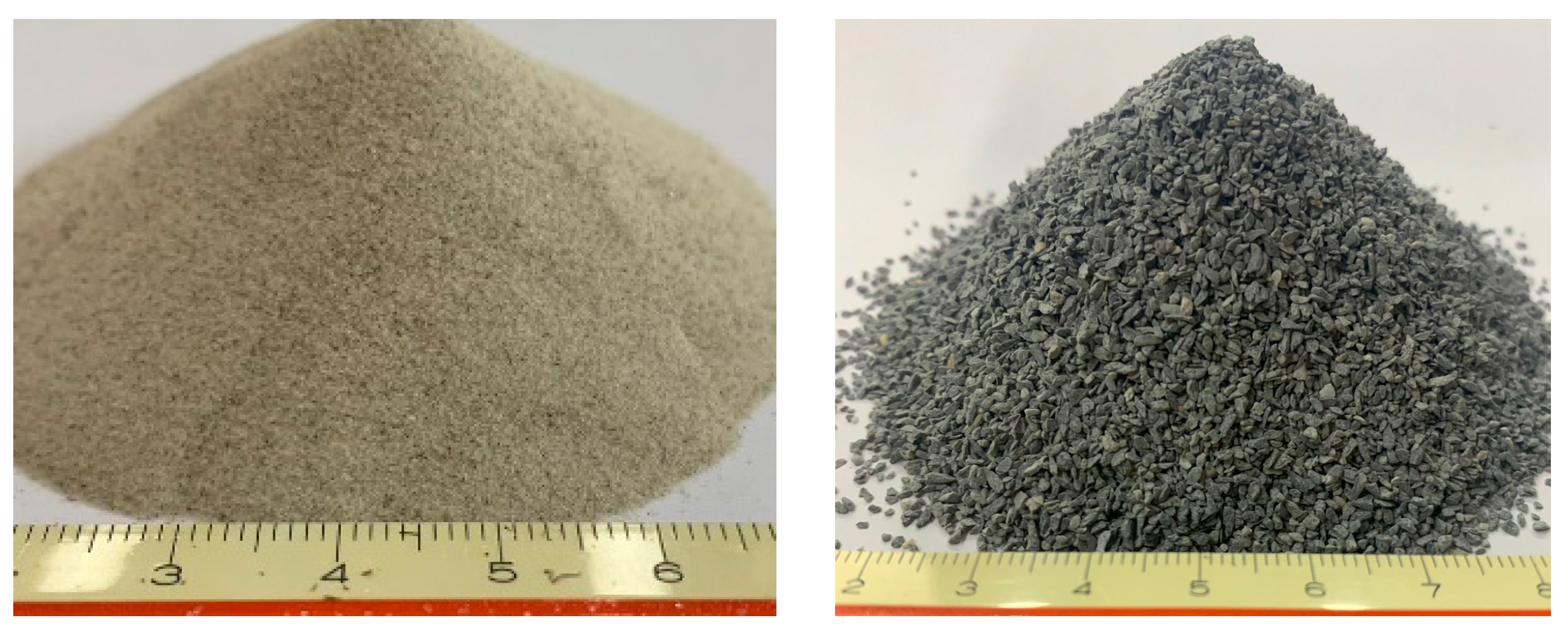
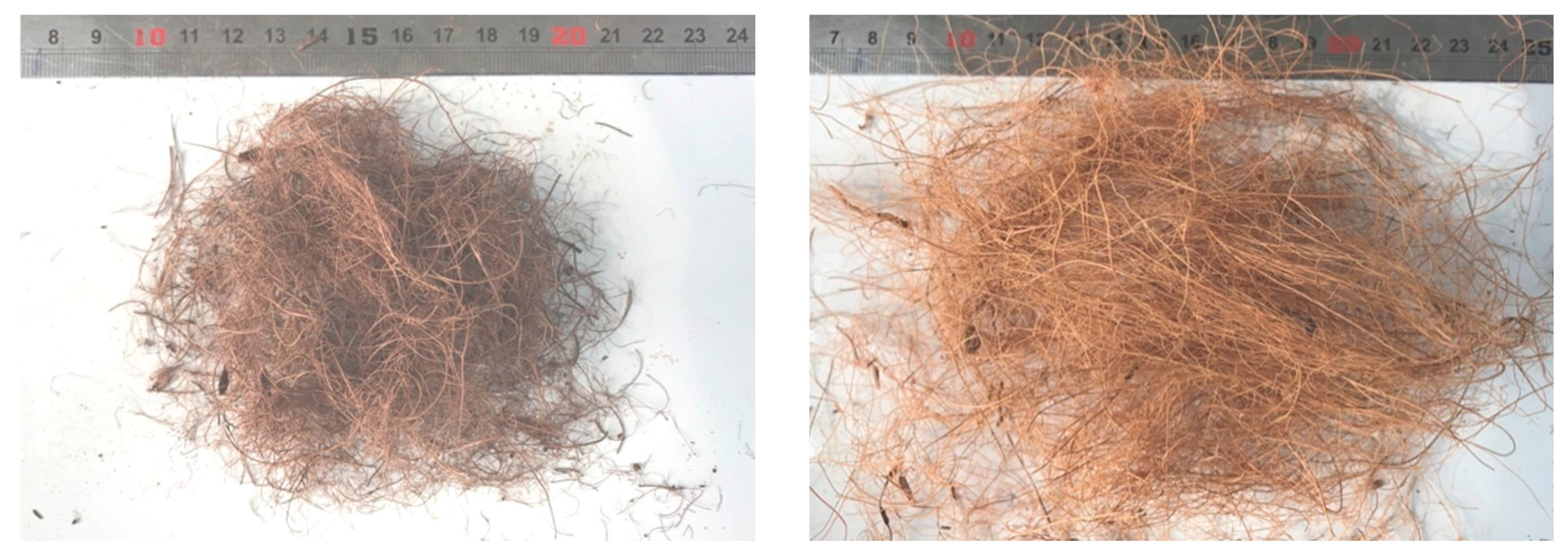
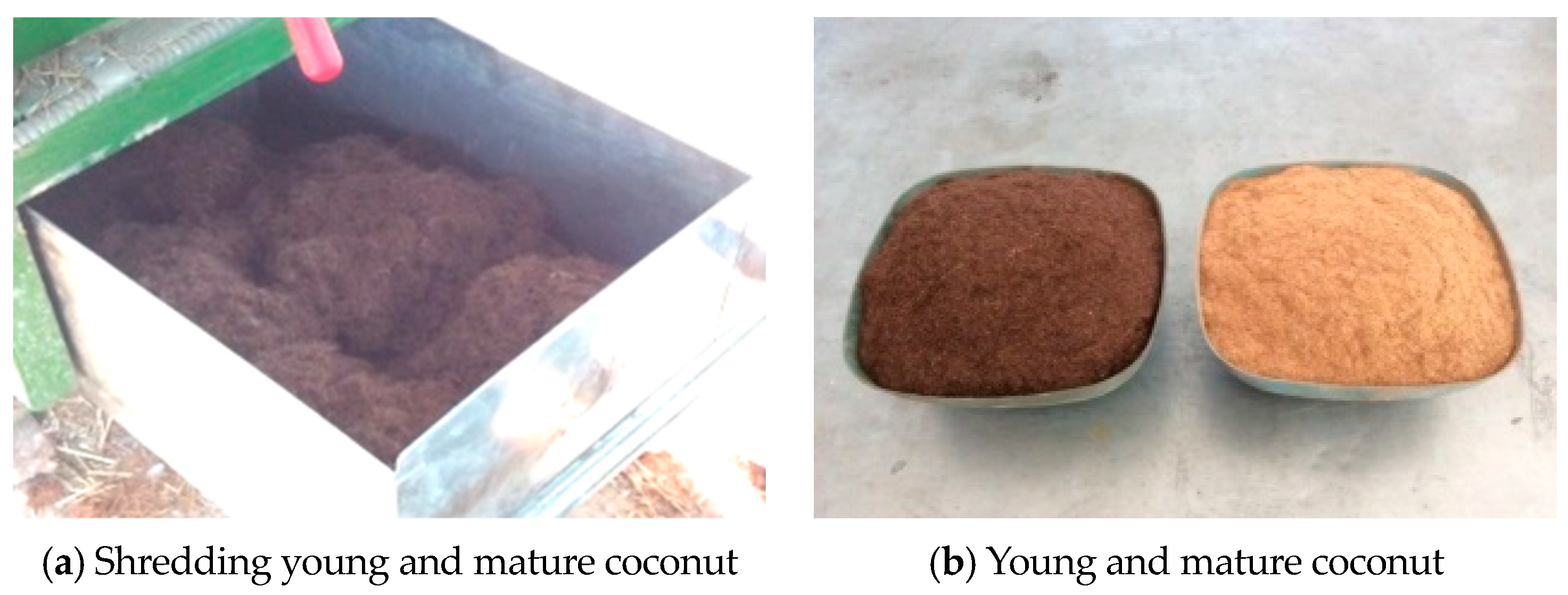
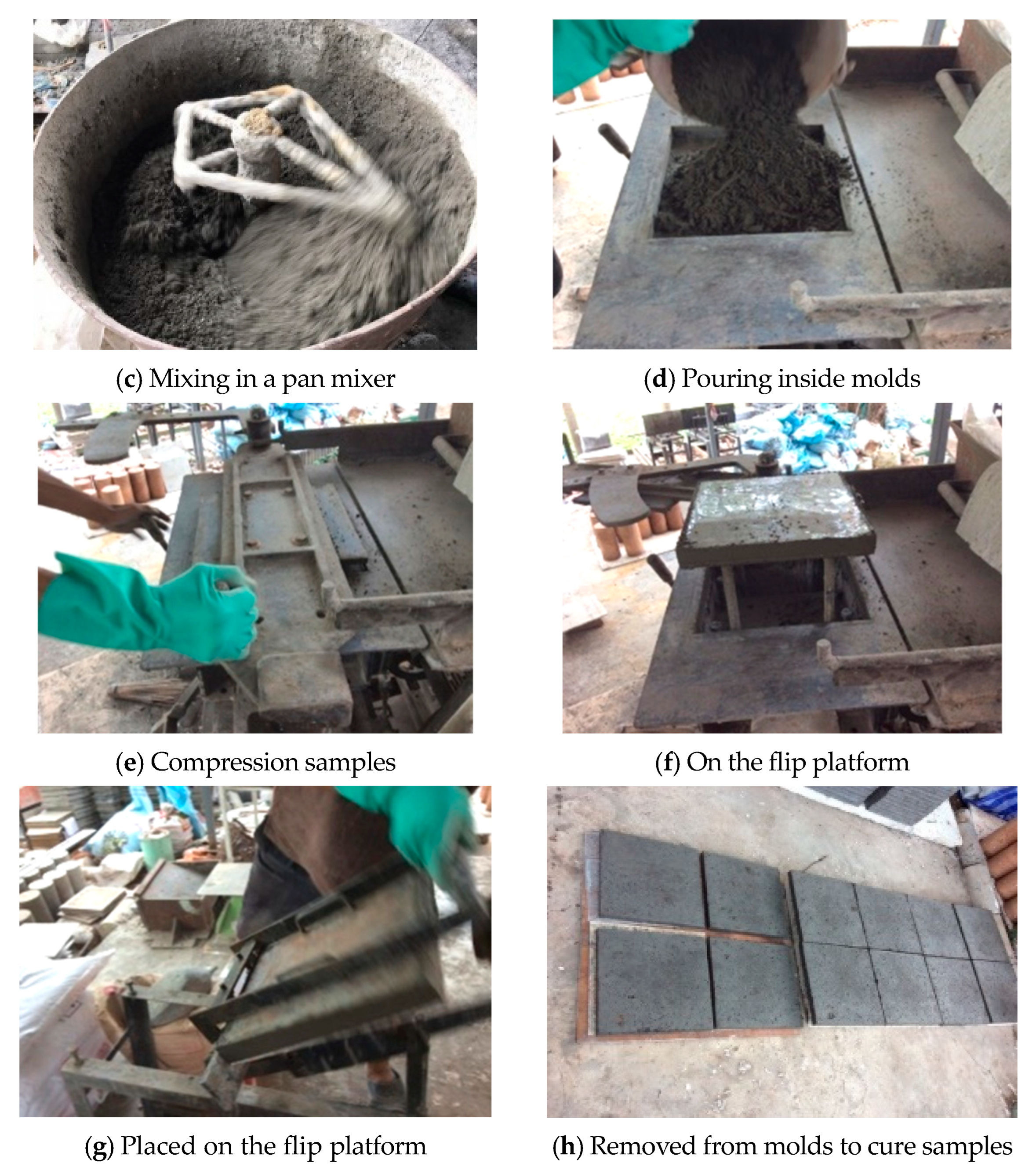
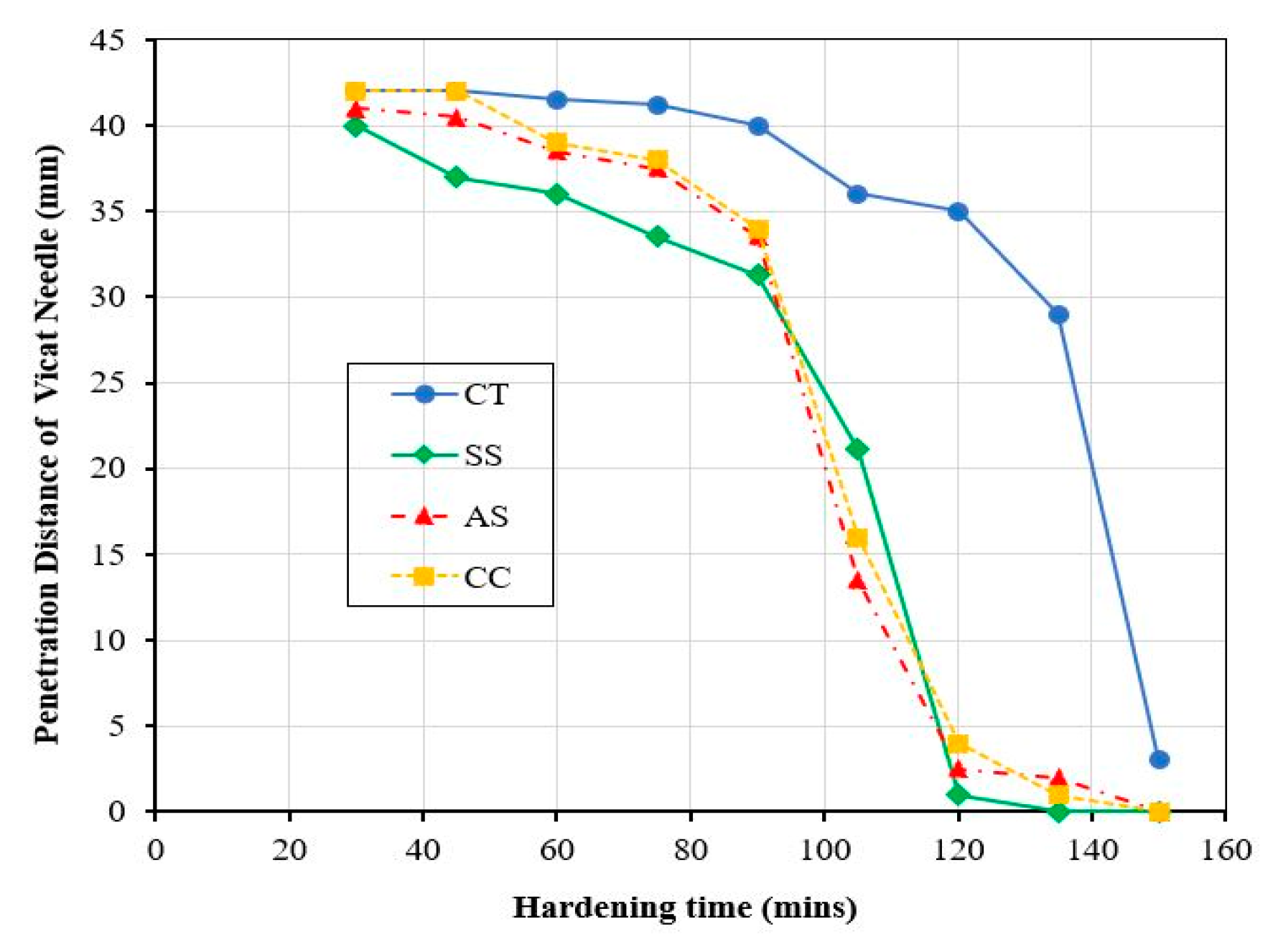
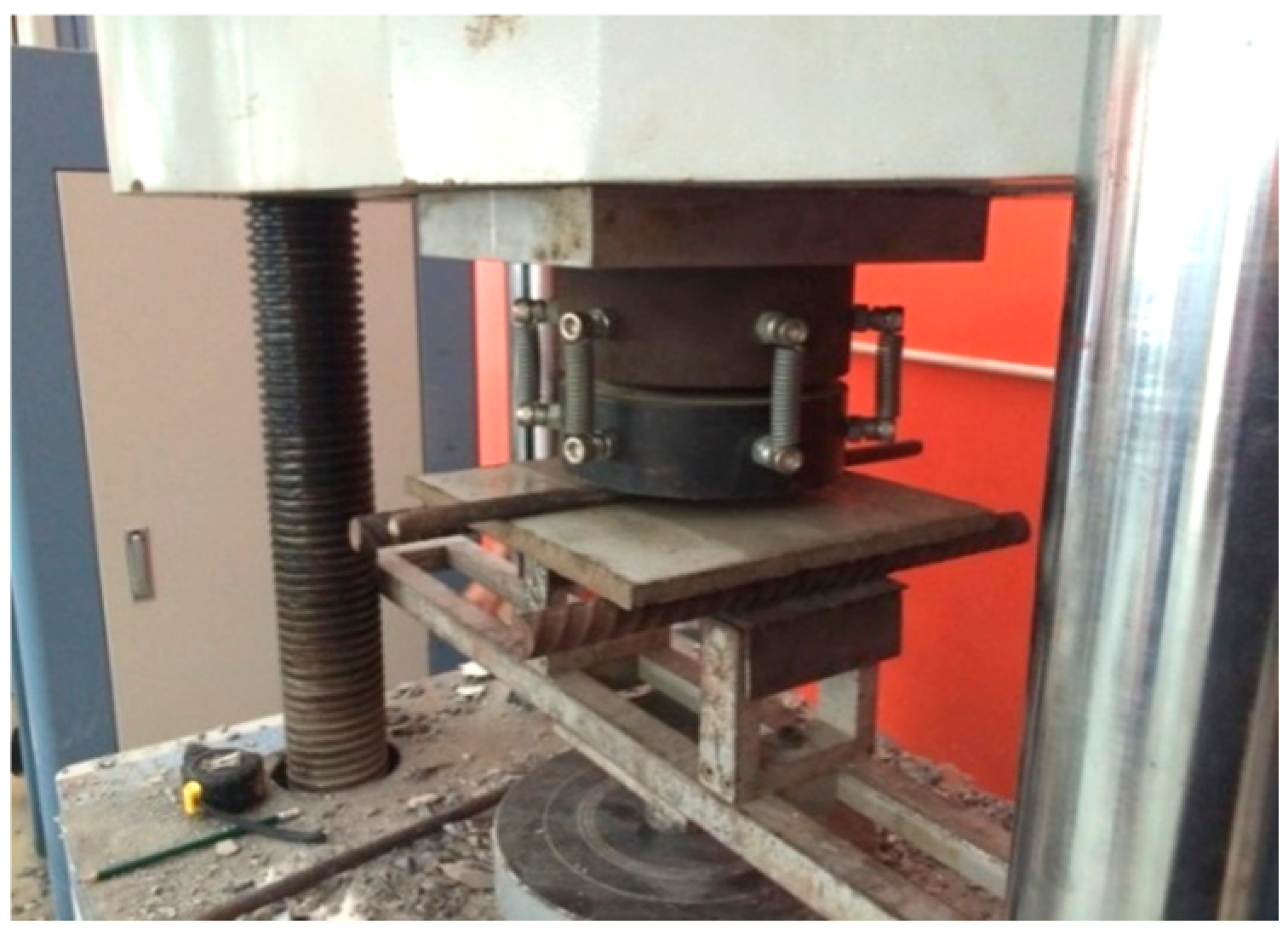
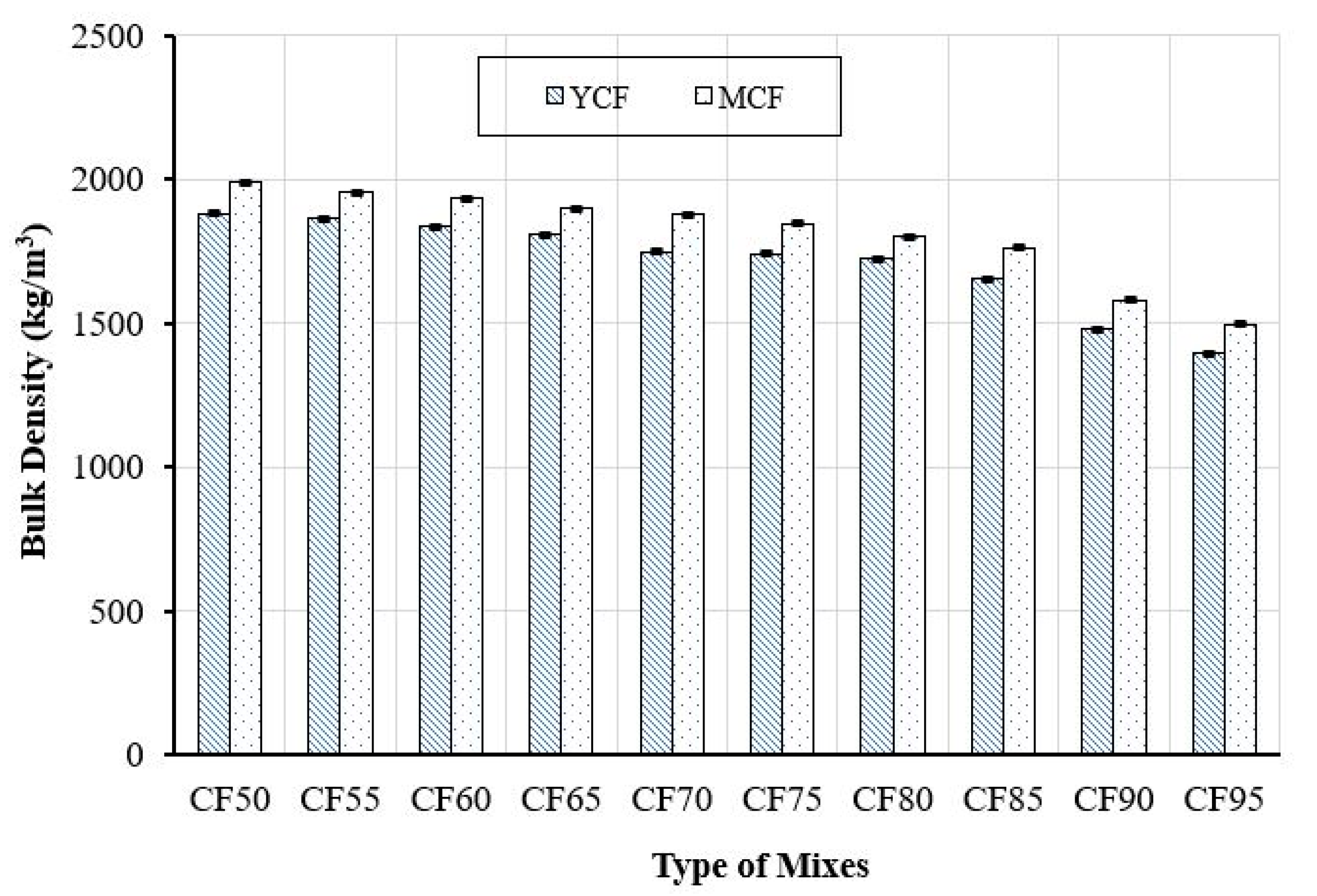
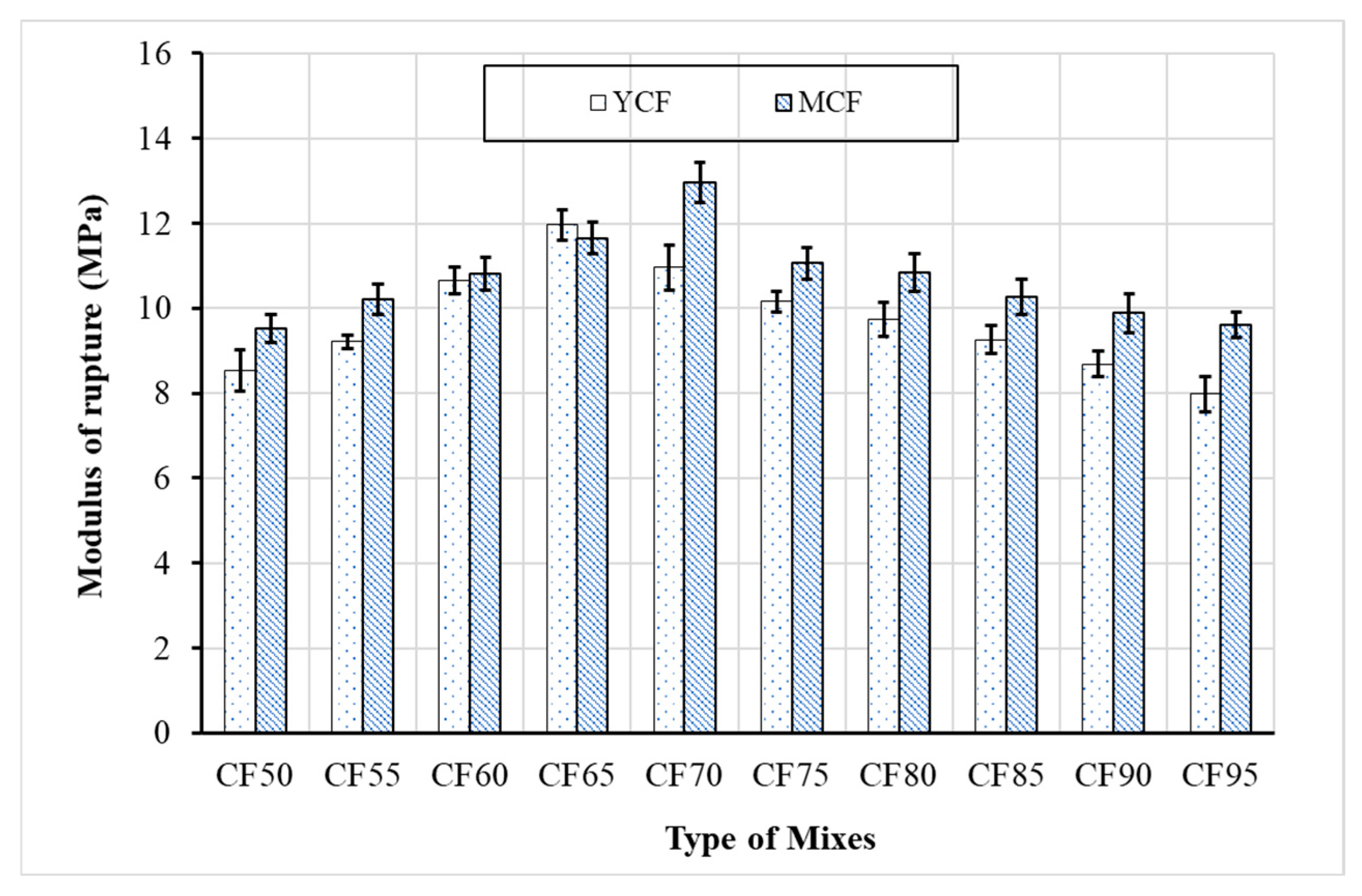


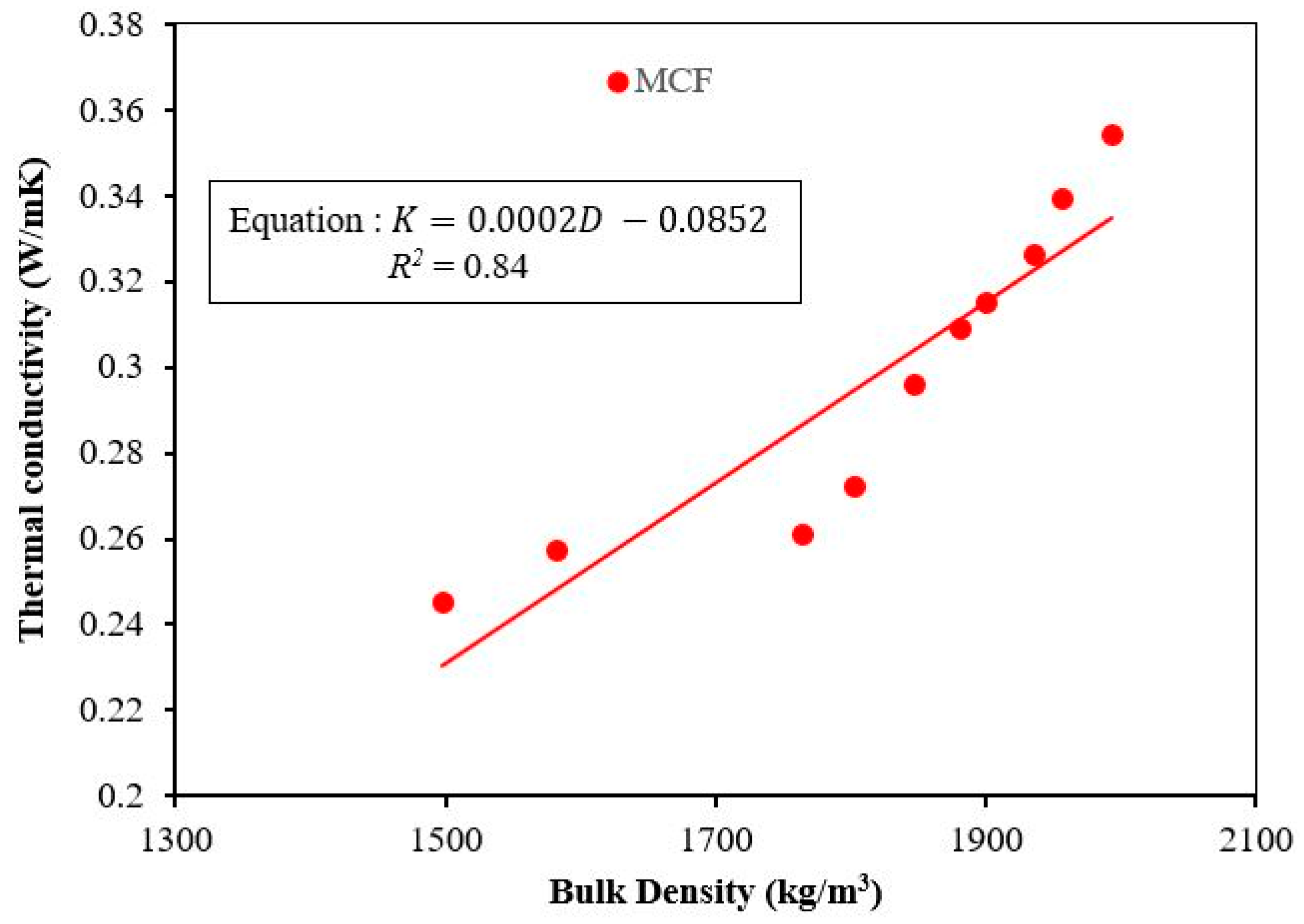

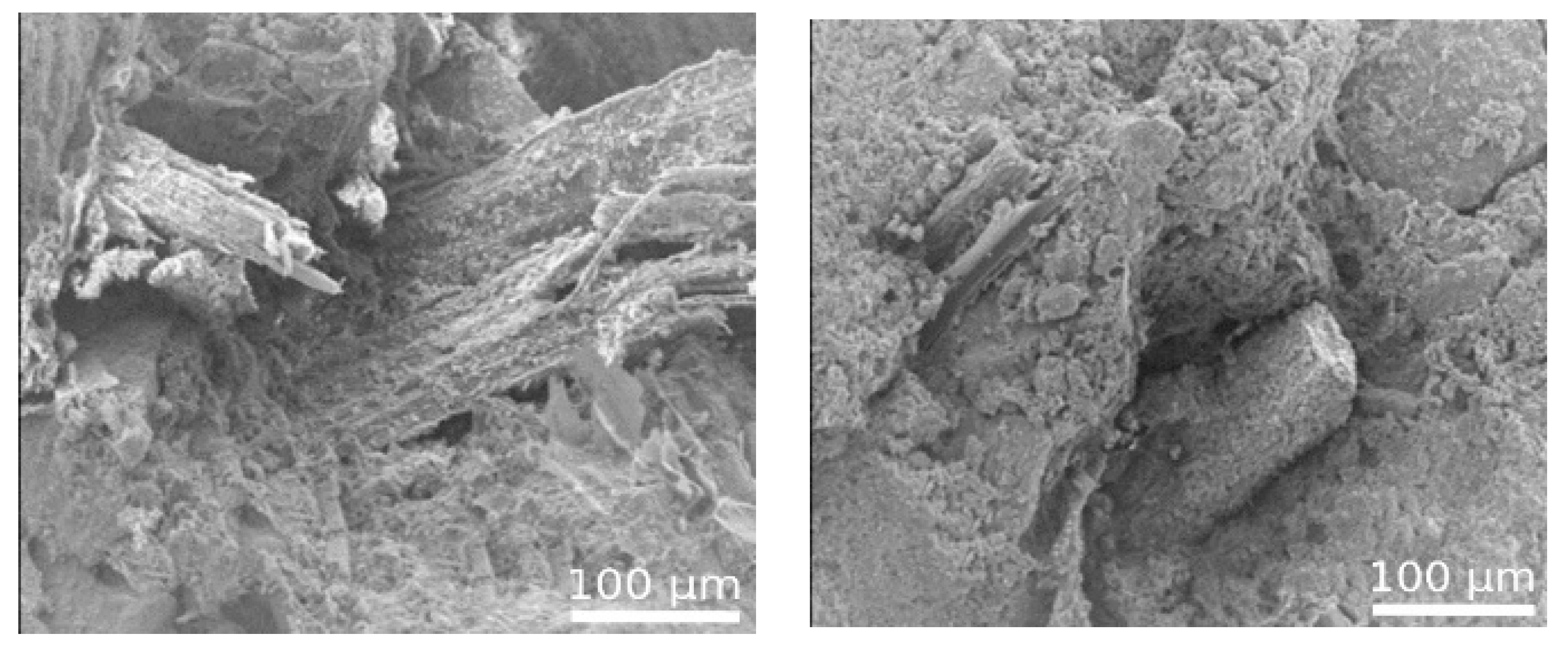
| Chemical Composition (%) | OPC |
|---|---|
| Silicon dioxide (SiO2) | 20.2 |
| Aluminum oxide (Al2O3) | 4.3 |
| Ferric oxide (Fe2O3) | 3.5 |
| Calcium oxide (CaO) | 63.7 |
| Sulfur trioxide (SO3) | 0.26 |
| Magnesium oxide (MgO) | 1.3 |
| Sodium oxide (Na2O) | 0.32 |
| Potassium oxide (K2O) | 2.62 |
| Loss on ignition (LOI) | 2.77 |
| Physical properties | |
| Specific gravity | 3.15 |
| Retained on a 325 sieve (% by weight) | 20.1 |
| Physical Characteristics | Fine Coarse Aggregate (FNA) | Crushed Rock Dust (CRD) |
|---|---|---|
| Fineness modulus | 3.2 | 3.68 |
| Specific gravity | 2.8 | 2.71 |
| Absorption (%) | 0.7 | 0.47 |
| Unit weight kg/m3 | 1840 | 1695 |
| Characteristics | Young Coconut Fiber | Mature Coconut Fiber |
|---|---|---|
| Split tensile strength (MPa) | 148.22 | 141.50 |
| Moisture content (%) | 11.11 | 11.61 |
| Elongation (%) | 21.39 | 27.72 |
| Diameter () | 208.52 | 116.48 |
| Mix Proportion | OPC (g) | FNA (g) | CRD (g) | YCF/MCF (g) | Water (g) |
|---|---|---|---|---|---|
| CF-50 | 1000 | 1000 | 1000 | 50 | 400 |
| CF-55 | 1000 | 1000 | 1000 | 55 | 400 |
| CF-60 | 1000 | 1000 | 1000 | 60 | 400 |
| CF-65 | 1000 | 1000 | 1000 | 65 | 400 |
| CF-70 | 1000 | 1000 | 1000 | 70 | 400 |
| CF-75 | 1000 | 1000 | 1000 | 75 | 400 |
| CF-80 | 1000 | 1000 | 1000 | 80 | 400 |
| CF-85 | 1000 | 1000 | 1000 | 85 | 400 |
| CF-90 | 1000 | 1000 | 1000 | 90 | 400 |
| CF-95 | 1000 | 1000 | 1000 | 95 | 400 |
Disclaimer/Publisher’s Note: The statements, opinions and data contained in all publications are solely those of the individual author(s) and contributor(s) and not of MDPI and/or the editor(s). MDPI and/or the editor(s) disclaim responsibility for any injury to people or property resulting from any ideas, methods, instructions or products referred to in the content. |
© 2024 by the authors. Licensee MDPI, Basel, Switzerland. This article is an open access article distributed under the terms and conditions of the Creative Commons Attribution (CC BY) license (https://creativecommons.org/licenses/by/4.0/).
Share and Cite
Khamput, P.; Klathae, T.; Choosakul, C.; Dueramae, S. The Development of Fiber–Cement Flat Sheets by Young and Mature Coconut Fibers to Replace Asbestos for Eco-Friendly Products. Appl. Sci. 2024, 14, 10786. https://doi.org/10.3390/app142310786
Khamput P, Klathae T, Choosakul C, Dueramae S. The Development of Fiber–Cement Flat Sheets by Young and Mature Coconut Fibers to Replace Asbestos for Eco-Friendly Products. Applied Sciences. 2024; 14(23):10786. https://doi.org/10.3390/app142310786
Chicago/Turabian StyleKhamput, Prachoom, Tawich Klathae, Chookiat Choosakul, and Saofee Dueramae. 2024. "The Development of Fiber–Cement Flat Sheets by Young and Mature Coconut Fibers to Replace Asbestos for Eco-Friendly Products" Applied Sciences 14, no. 23: 10786. https://doi.org/10.3390/app142310786
APA StyleKhamput, P., Klathae, T., Choosakul, C., & Dueramae, S. (2024). The Development of Fiber–Cement Flat Sheets by Young and Mature Coconut Fibers to Replace Asbestos for Eco-Friendly Products. Applied Sciences, 14(23), 10786. https://doi.org/10.3390/app142310786








